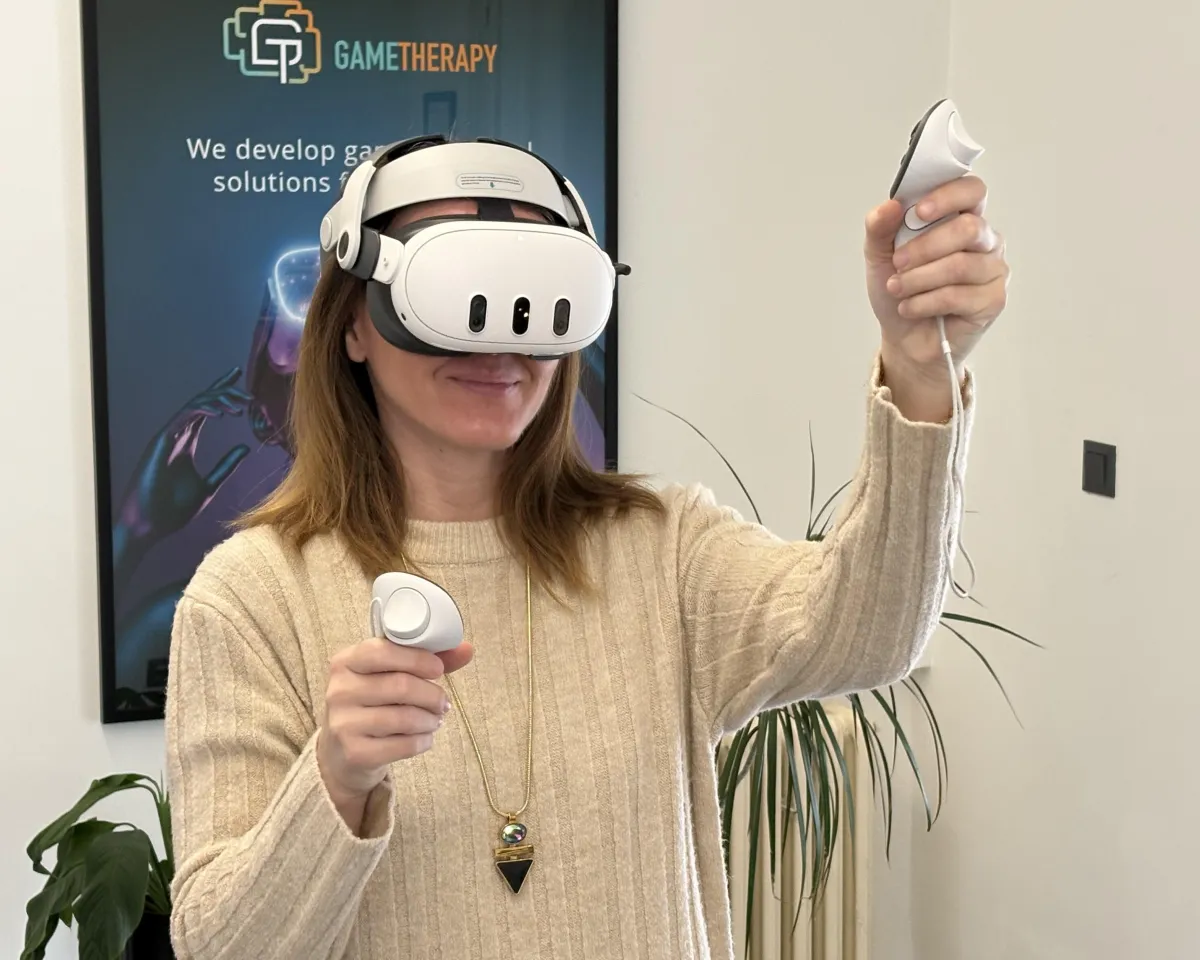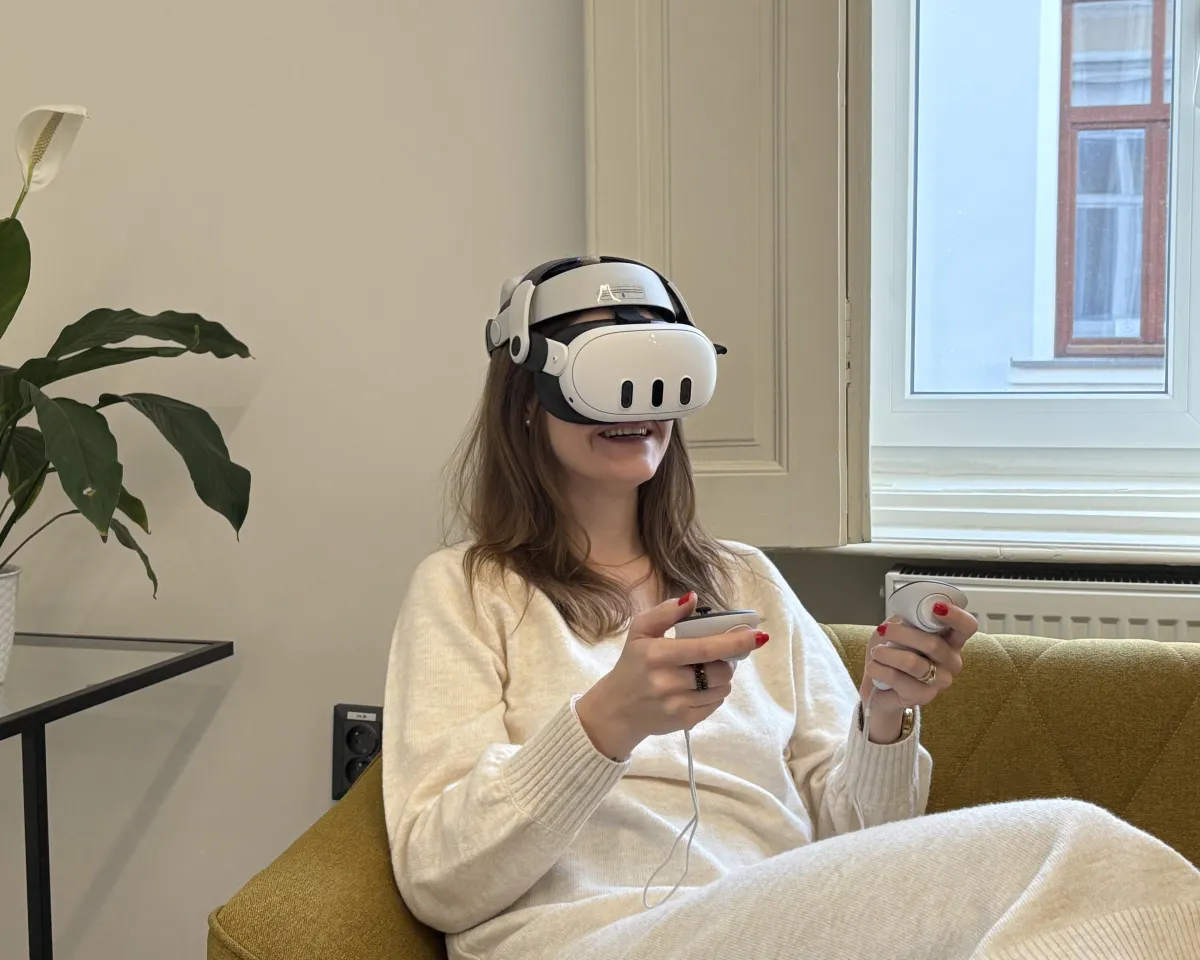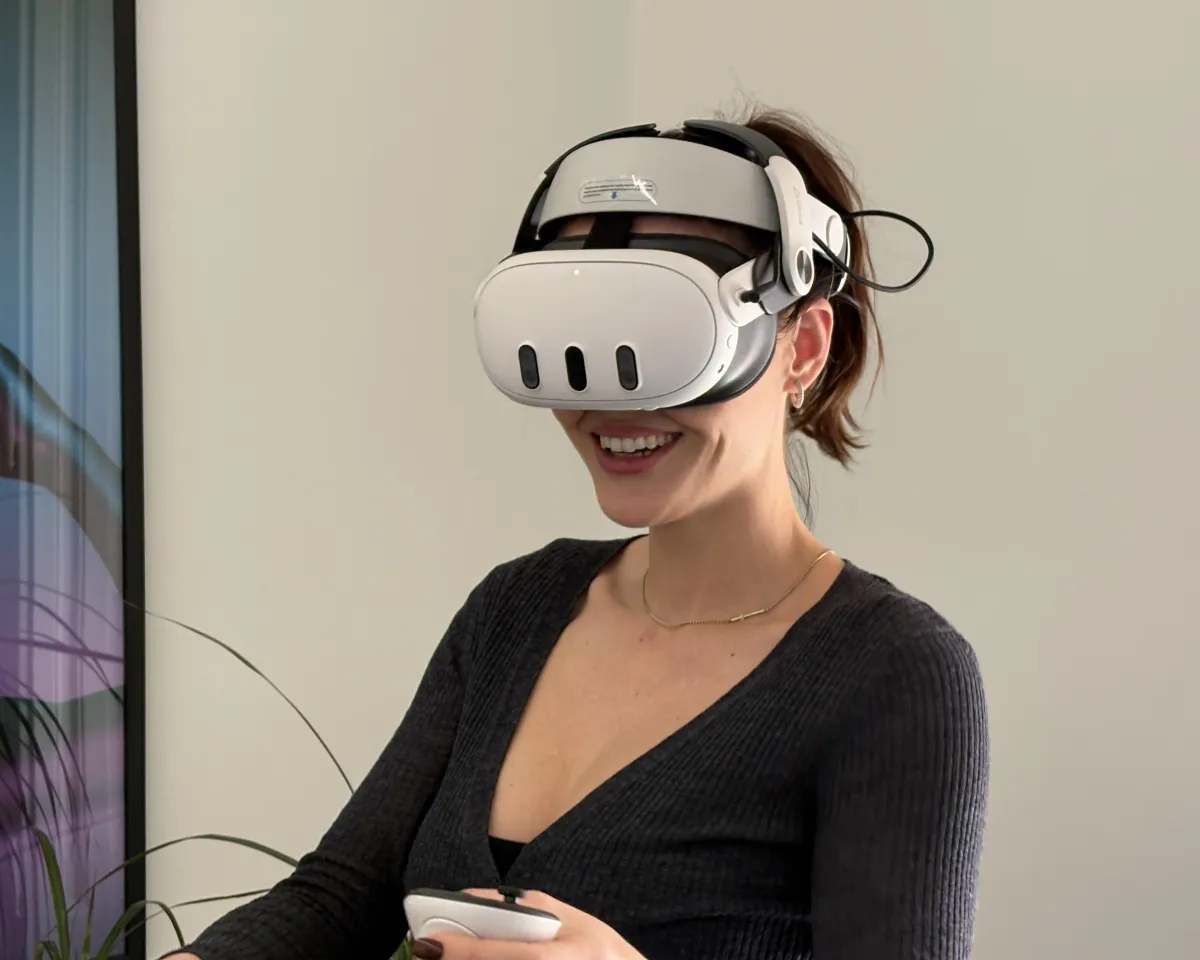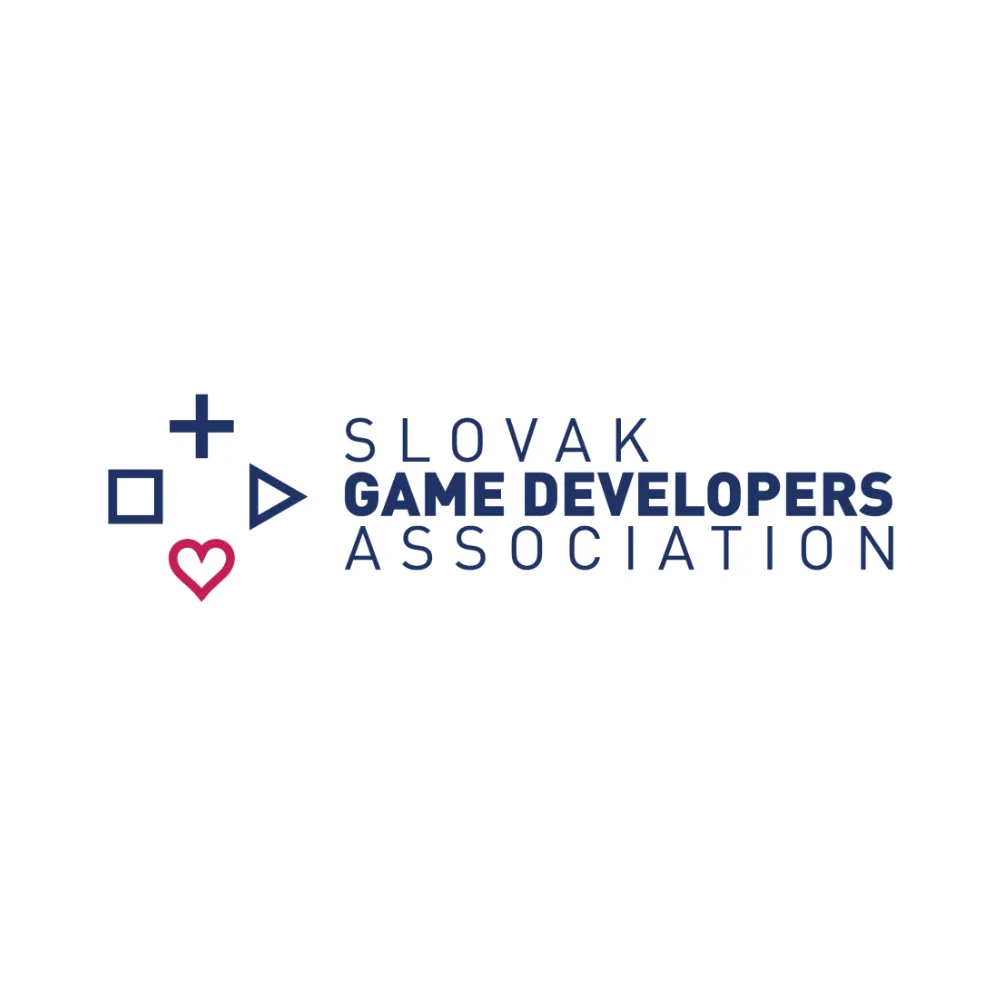BRIDGING RESEARCH, TECHNOLOGY, AND THE GAMING WORLD
Your partner in cutting-edge software development
Our mission is to transform human well-being and human-computer interaction. We do this by integrating virtual reality, augmented reality, and artificial intelligence technologies. At the heart of our philosophy is game-therapy. We create innovative, scientifically grounded, yet playful solutions for a wide range of challenges.

IMPACTFUL TOOLS FOR A BETTER QUALITY OF LIFE
Our products
ClaustrOFF
A game created with cutting-edge research to help you overcome fears in a safe, engaging, and effective way
NeuroBoostVR
Innovative exercises for seniors and others to improve motor skills, balance, and orientation with simple, effective activities
VIRADIA
Virtual Reality Platform for Early Diagnosis of Neurodegenerative Diseases, Revolutionizing Neurological Diagnostics
Experience the full power of VR for positive well-being
With a commitment to innovation and the transformative power of VR, we aim to make a lasting impact on mental health, education, industry, and personal growth, all grounded in scientific research and designed to enhance well-being worldwide.

GROWTH THROUGH INNOVATIONS
The GAMETHERAPY model
We harness the power of new technologies. By making care and training more accessible and tailored, we empower individuals and organizations to thrive. Rooted in scientific research, our innovative approach drives meaningful change, transforming mental health, education, healthcare, industry, and personal growth on a global scale.
SOLUTIONS THAT MAKE AN IMPACT
Immersive solutions for mental health and beyond
Our primary focus is on creating immersive applications that empower individuals to overcome challenges like anxiety, phobias, and neurological conditions. These solutions are designed to enhance well-being and unlock potential across various aspects of life, showcasing our expertise in innovative and impactful technologies.
Engaging VR/AR solutions for soft skills training
Evaluation in neurology and rehabilitation
General education
Personal development
Industrial training
Industry 5.0 applications

Join the Mind Heaven Community!
Be part of our journey to transform mental health care and well-being through innovation and gamification. By signing up, you’ll gain access to exclusive psychological content, enjoy discounts on our products, and stay updated with the latest news about our projects. You’ll also discover unique content like game stories and behind-the-scenes insights into our app development process. We value your ideas and feedback to make our games even better. Join us, become a co-creator, and help shape the future of the Mind Heaven Community!

The Science Behind Panic Attacks and How to Stop Them
The Science Behind Panic Attacks and How to Stop Them

"Panic attacks can feel overwhelming, but understanding the science behind them is the first step to regaining control and finding calm." – Dr. Martin Polák
Panic attacks can strike suddenly, leaving you feeling helpless and out of control. But the more you understand about what’s happening in your body and mind during a panic attack, the better equipped you’ll be to manage and stop them. In this post, we’ll break down the science behind panic attacks and provide practical strategies for stopping them in their tracks.
What is a Panic Attack?
A panic attack is a sudden episode of intense fear or discomfort that triggers physical symptoms, even when there is no real danger. Common symptoms include a racing heart, shortness of breath, dizziness, sweating, and an overwhelming sense of doom. Panic attacks typically peak within 10 minutes and subside within 20–30 minutes, though they can feel much longer to those experiencing them.
The Science Behind Panic Attacks
Panic attacks occur when your body’s "fight-or-flight" response is activated unnecessarily. Here’s what happens step-by-step:
Trigger Identification: A specific event, thought, or even no clear cause can trigger your brain to perceive danger.
Amygdala Activation: The amygdala, your brain’s fear center, sends a signal that you’re in danger, even if no real threat exists.
Adrenaline Surge: Your body releases adrenaline, causing a rapid heart rate, shallow breathing, and muscle tension.
Hyperventilation: Quick, shallow breathing reduces carbon dioxide levels in the blood, leading to dizziness and tingling sensations.
Cognitive Misinterpretation: Your brain may misinterpret these physical sensations as life-threatening, intensifying your fear and creating a vicious cycle.
Understanding that these symptoms are your body’s normal response to perceived danger can help you realize that a panic attack, while uncomfortable, is not harmful or dangerous.
How to Stop a Panic Attack
Here are proven strategies to help you regain control during a panic attack:
1. Focus on Your Breathing
Breathing techniques can interrupt hyperventilation and restore calm:
Try 4-7-8 Breathing: Inhale through your nose for 4 seconds, hold for 7 seconds, and exhale slowly for 8 seconds.
Another option is Box Breathing: Inhale for 4 seconds, hold for 4 seconds, exhale for 4 seconds, and hold for another 4 seconds. Repeat.
2. Ground Yourself with the 5-4-3-2-1 Method
This mindfulness technique redirects your focus from fear to the present moment:
Identify 5 things you can see.
Recognize 4 things you can touch.
Notice 3 things you can hear.
Acknowledge 2 things you can smell.
Focus on 1 thing you can taste.
3. Challenge Unhelpful Thoughts
Write down or mentally question the thoughts fueling your panic. Ask yourself:
Is this thought based on fact or fear?
What evidence do I have that supports or refutes this thought?
What’s the worst that can happen, and how likely is it?
4. Use Muscle Relaxation Techniques
Progressive muscle relaxation involves tensing and relaxing muscle groups to release physical tension:
Start with your toes and gradually work up to your head.
Inhale as you tense, and exhale as you release.
5. Use Cold Water to Reset
Splashing your face with cold water or holding an ice cube can trigger the "dive reflex," slowing your heart rate and calming your nervous system.
Preventing Future Panic Attacks
While it’s helpful to manage panic attacks in the moment, taking steps to reduce their frequency is equally important. Here’s how:
Practice Regular Breathing Exercises: Controlled breathing can train your body to remain calm under stress.
Engage in Physical Activity: Regular exercise reduces stress hormones and boosts mood-enhancing endorphins.
Get Adequate Sleep: Sleep deprivation can exacerbate anxiety and panic attacks.
Limit Stimulants: Reduce caffeine and alcohol, as these can increase anxiety symptoms.
Consider Therapy: Cognitive-behavioral therapy (CBT) is highly effective in helping individuals reframe anxious thoughts and break the cycle of panic attacks.
Key Takeaways
Panic attacks are intense but not dangerous; they’re your body’s response to perceived danger.
Understanding the science behind them can demystify the experience and empower you to take control.
Practical strategies like breathing techniques, grounding exercises, and cognitive reframing can help stop a panic attack.
Long-term prevention involves lifestyle adjustments, mindfulness, and professional support when needed.
References
Barlow, D. H., & Craske, M. G. (2021). Mastery of Your Anxiety and Panic: Workbook. Oxford University Press.
Chalmers, J. A., & Quintana, D. S. (2022). The autonomic nervous system's role in regulating fear and panic. Frontiers in Neuroscience.
Hofmann, S. G., & Smits, J. A. (2019). Cognitive-behavioral therapy for anxiety disorders: An update on the empirical evidence. Psychiatric Clinics of North America.
Garssen, B. (2020). The mechanism of breathing exercises in panic disorder. Journal of Anxiety Disorders.
Kim, J. J., & Fanselow, M. S. (2018). Modulation of the amygdala in anxiety and panic. Nature Reviews Neuroscience.
By understanding the science of panic attacks and applying these techniques, you can begin to take control of your anxiety. Remember, you’re not alone, and effective tools are available to help you regain calm and confidence.






